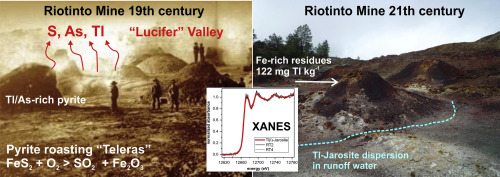Science of the Total Environment ( IF 9.8 ) Pub Date : 2018-08-21 , DOI: 10.1016/j.scitotenv.2018.08.260 Paula López-Arce , Fernando Garrido , Javier García-Guinea , Andreas Voegelin , Jörg Göttlicher , Jose Miguel Nieto

|
Samples of an open-air pyrite roasting heap from the 19th century in the Riotinto mine area (SW Spain) and surrounding sediments and soil along a seasonal surface runoff channel were analyzed to study thallium (Tl) phase transformations during historical roasting of Tl-bearing arsenian pyrite, secondary weathering processes, Tl dispersion and current environmental pollution. Results from Electron Probe Microanalyses (EPMA) indicate an even distribution of Tl in pyrite grains of an ore sample (22 mg kg−1 total Tl), suggesting that Tl is incorporated in the pyrite structure rather than in discrete Tl-sulfide microparticles. The roasting residue (122 mg kg−1 total Tl) consists mainly of hematite. EPMA suggested that Tl in the roasting residue and contaminated soil was co-occurring with Fe oxide particles, with a mean Tl point concentration of 0.12% in samples from the roasting residues. Total concentrations of Tl in soil samples decrease with distance from the roasting heap to 14 mg kg−1. X-ray absorption near-edge structure (XANES) spectra collected on pyrite roasting residue and a soil sample suggest that most Tl is Tl(I) substituting K in jarosite. Sequential extractions show that most Tl (85–99%) in the soil and sediment samples is concentrated in the residual fraction and, thus, is rather strongly bound. Lastly, water extracts indicate that colloidal particles (i.e. <1 μm size) may contribute to the dispersion of Tl around and away from the roasting heaps.
中文翻译:

ro和砷黄铁矿的历史焙烧:Riotinto矿区目前的Tl污染
分析了19世纪在Riotinto矿区(西班牙西南部)的露天黄铁矿焙烧堆以及沿季节性地表径流通道周围的沉积物和土壤的样品,以研究含Tl的历史焙烧过程中th(Tl)的相变。砷黄铁矿,二次风化过程,Tl扩散和当前环境污染。电子探针显微分析(EPMA)的结果表明,T1在矿石样品的黄铁矿晶粒中分布均匀(总T1为22 mg kg -1),表明T1掺入了黄铁矿结构中,而不是分散的T1-硫化物微粒中。焙烧残渣(122 mg kg -1总T1)主要由赤铁矿组成。EPMA建议,烘烤残留物和受污染土壤中的T1与氧化铁颗粒同时存在,来自烘烤残留物的样品中T1点的平均浓度为0.12%。土壤样品中T1的总浓度随着从焙烧堆到14 mg kg -1的距离而降低。在黄铁矿焙烧残渣和土壤样品上收集的X射线吸收近边缘结构(XANES)光谱表明,大多数Tl是用黄钾铁矾中的K代替K的Tl(I)。顺序提取显示,土壤和沉积物样品中的大多数T1(85-99%)集中在残留部分中,因此具有很强的束缚力。最后,水提取物表明胶体颗粒(即<1μm大小)可能有助于T1在焙烧堆周围和远离焙烧堆的分散。


























 京公网安备 11010802027423号
京公网安备 11010802027423号